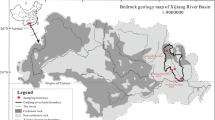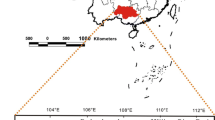Abstract
Carbon sequestration resulting from carbonate rock weathering is closely linked to the global carbon cycle and has turned out to be important in the adjustment of atmospheric CO2 levels. Traditional karst dynamic models based on water–rock–gas interactions underestimate carbon sink fluxes related to carbonate rock weathering because they ignore the utilization of dissolved inorganic carbon (DIC) by aquatic organisms. In this study, a new model based on water–rock–gas–organism interactions was applied in the Pearl River basin, China, to recalculate atmospheric CO2 consumption and to develop an accurate estimation model for carbon sink fluxes at catchment scale. Stable carbon isotope (δ13C) and C/N ratios were used in the counting processes. Data were collected from published literature as well as through field investigation and laboratory analysis. Results show that the Pearl River carbon sink in the Pearl River is 4.31 × 109 kg/a, i.e., 15.8 × 109 kg of atmospheric CO2 per year. Of this, the carbon sink resulting from carbonate rock weathering amounts to 2.14 × 109 kg/a, i.e., 49.7 % of the total. The three largest tributaries of Pearl River, Dongjiang, Beijiang, and Xijiang, respectively absorb 0.5 × 109, 1.19 × 109, and 2.62 × 109 kg of carbon from the atmosphere annually, accounting for 12, 28 and 60 % of the river’s total carbon sink. When compared with the results of previous researches that disregarded the role of aquatic organisms, the new calculation method provides a carbon sink flux value that is 1.2–3.3 times higher, and 1.6 times higher on an average. To improve the calculation accuracy of atmospheric CO2 consumption in global karstic rivers, further research is needed regarding carbon sequestration mechanisms that involve aquatic organisms.


Similar content being viewed by others
References
Amiotte-Suchet P, Aubert D, Probst J-L, Gauthier-Lafaye F, Probst A, Andreux F, Viville D (1999) δ13C pattern of dissolved inorganic carbon in a small granitic catchment: the Strengbach case study (Vosges mountains, France). Chem Geol 159:129–145
Baldini JU, Baldini LM, McDermott F, Clipson N (2006) Carbon dioxide sources, sinks, and spatial variability in shallow temperate zone caves: evidence from Ballynamintra Cave, Ireland. J Cave Karst Stud 68:4–11
Callahan J, Dai M, Chen RF, Li X, Lu Z, Huang W (2004) Distribution of dissolved organic matter in the Pearl River estuary, China. Mar Chem 89:211–224
Cao JH, Yang H, Kang ZQ (2011) Preliminary regional estimation of carbon sink flux by carbonate rock corrosion: a case study of the Pearl River Basin. Chin Sci Bull 56:1–8
Cassar N, Laws EA, Bidigare RR, Popp BN (2004) Bicarbonate uptake by Southern ocean phytoplankton. Glob Biogeochem Cycles 18:1–10
Cerling TE, Solomon DK, Quade J, Bowman JR (1991) On the isotopic composition of carbon in soil carbon dioxide. Geochim Cosmochim Acta 55:3403–3405
Cole J, Prairie Y, Caraco N, McDowell W, Tranvik L, Striegl R, Duarte C, Kortelainen P, Downing J, Middelburg J (2007) Plumbing the global carbon cycle: integrating inland waters into the terrestrial carbon budget. Ecosystems 10:172–185
Curl RL (2012) Carbon shifted but not sequestered. Science 335:6069
De Montety V, Martin J, Cohen M, Foster C, Kurz M (2011) Influence of diel biogeochemical cycles on carbonate equilibrium in a karst river. Chem Geol 83:31–43
Dean WE, Gorham E (1998) Magnitude and significance of carbon burial in lakes, reservoirs, and peatlands. Geology 26:535–538
Einsele G, Yan J, Hinderer M (2001) Atmospheric carbon burial in modern lake basins and its significance for the global carbon budget. Glob Planet Change 30:167–195
Fritz P, Fontes JC, Frape S, Louvat D, Michelot J, Balderer W (1989) The isotope geochemistry of carbon in groundwater at Stripa. Geochim Cosmochim Acta 53:1765–1775
Gao Q, Sheng C, Yi W, Sun Y, Xing C, Tao Z (2001) Chemical weathering in Zhujiang River drainage. Geochimica 30(3):223–230 (in Chinese with English abstract)
Gao Q, Tao Z, Xie M, Cui K, Zeng F (2003) Effects of hydrological processes on the chemical composition of riverine suspended sediment in the Zhujiang River, China. Hydrol Process 17:2365–2373
Grossman EL (1997) Stable carbon isotopes as indicators of microbial activity in aquifers. Man Environ Microbiol 565–576
Groves C, Cao J, Zhang C (2012) Carbon shifted but not sequestered response. Science 335:6069
Jiang Z, Yuan D (1999) CO2 source-sink in karst processes in karst areas of China. Episodes 22:33–35
Jiang Z, Yuan D, Cao J, Qin X, He S, Zhang C (2012) A study of carbon sink capacity of karst processes in China. Acta Geosci Sin 33(2):129–134 (in Chinese with English abstract)
Larson C (2011) An unsung carbon sink. Science 334:886–887
Li S, Liu C, Tao F, Lang Y-C, Han G (2004) Chemical and stable carbon isotopic compositions of the ground waters of Guiyang City, China: implications for biogeochemical cycle of carbon and contamination. Geochimica 33(2):165–170 (in Chinese with English abstract)
Li T, Ji H, Jiang Y, Wang L (2007) Hydro-geochemistry and the sources of DIC in the upriver tributaries of the Ganjiang River. Acta Geogr Sin 62:764
Liu X, (2007) Hydrological characteristics analysis of Shijiao hydrological station of Beijiang. Heilongjiang Sci Technol Inform 22, 35 (in Chinese with English abstract)
Liu Z (2012) New progress and prospects in the study of rock-weathering-related carbon sinks. Chin Sci Bull 57:95–102
Liu Z, Weng D, Wang J (2007) A significant atmospheric CO2 sink caused by global water cycle. Chin Sci Bull 52(20):2417–2422 (in Chinese with English abstract)
Liu Z, Dreybrodt W, Wang H (2010) A new direction in effective accounting for the atmospheric CO2 budget: considering the combined action of carbonate dissolution, the global water cycle and photosynthetic uptake of DIC by aquatic organisms. Earth Sci Rev 99:162–172
Liu Z, Dreybrodt W, Liu H (2011) Atmospheric CO2 sink: silicate weathering or carbonate weathering? Appl Geochem 26:S292–S294
Niu H, Wu Q, Chen X (2008) Distribution characteristics and fertility assessment of nutrients in surface sediment in Guangzhou section of Pearl River. Mar Environ Sci 27(4):348–351 (in Chinese with English abstract)
Parrick JM, Jerry E (1982) The role of lake and reservoir sediments as sinks in the perturbed global carbon cycle. Tellus 34:490–499
Shao L, Dou J, Zhang P (1996) Paleogeographic significances of carbon and oxygen isotopes in late permian rocks of Southwest China. Geochimica 25(6):575–581 (in Chinese with English abstract)
Smith SV, Gattuso J-P (2011) Balancing the oceanic calcium carbonate cycle: consequences of variable water column. Aquat Geochem 17:327–337
Staddon PL (2004) Carbon isotopes in functional soil ecology. Tr Ecol Evol 19(3):148–154
Tao S, Liang T, Xu S, Di W (1997) Temporal and spatial variation of dissolved organic carbon content and its flux in yichun river. Acta Geogr sin 3(52):254–561 (in Chinese with English abstract)
Tao Z, Gao Q, Yao G, Shen C, Wu Q, Wu Z, Liu G (2004) The sources, seasonal variation and transported fluxes of the riverine particulate organic carbon of the Zengjiang River South China. Acta Sci Circumst 24(5):789–795 (in Chinese with English abstract)
Tao FX, Liu CQ, Li SL (2009) Source and flux of POC in two subtropical karstic tributaries with contrasting land use practice in the Yangtze River Basin. Appl Geochem 24:2102–2112
Telmer K, Veizer J (1999) Carbon fluxes, PCO2 and substrate weathering in a large northern river basin, Canada: carbon isotope perspectives. Chem Geol 159:61–86
Wang Z, Chen X (2006) Net primary productivity and its spatio-temporal patterns in the Pearl river basin. Acta Sci Nat Univ Sunyatseni 45(6):106–110 (in Chinese with English abstract)
Wang Z, Chen X, Yang T (2010) Runoff variation and its impacting factors in the Dongjiang River basin during 1956–2005. J Nat Resour 25(8):1365–1374 (in Chinese with English abstract)
Waterson EJ, Canuel EA (2008) Sources of sedimentary organic matter in the Mississippi River and adjacent Gulf of Mexico as revealed by lipid biomarker and δ13CTOC analyses. Org Geochem 39:422–439
Wei X (2003) Study on riverine carbon flux and erosion of Zhujiang (Pearl River) drainage basin. In: PhD thesis, Guangzhou Institute of Geochemistry, Chinese Academy of Science. Guangzhou, China (in Chinese with English abstract)
Xing C (1998) Studies on 14C age and 14C tracing for subtropical forrest soils in south China. In: PhD thesis, Guangzhou Institute of Geochemistry, Chinese Acadamy of Sciences. Guangzhou, China (in Chinese with English abstract)
You D, Tang C, Deng S (2005) Preliminary analysis on relationship between the climate warming and the discharge of Xijiang River in the recent 50 Years. Guangdong Meteorol 4:4–6 (in Chinese with English abstract)
Yuan D (1993) Carbon cycle and global karst. Quat Sci 1:1–6 (in Chinese with English abstract)
Yuan D (1995) Karstification sensitivity and its record of environmental change. Chin Sci Bull 40(13):1210–1214 (in Chinese with English abstract)
Yuan D (1999) Progress in the study on karst processes and carbon cycle. Adv Earth Sci 14(5):425–432 (in Chinese with English abstract)
Zhang C (2011) Time-scale of karst processes and the carbon sink stability. Carsologica Sin 30(4):368–371 (in Chinese with English abstract)
Zhang Q (2012) The stability of carbon sink effect related to carbonate rock dissolution: a case study of the Caohai Lake geological carbon sink. Geosci Sin 33(6):947–952 (in Chinese with English abstract)
Zhang L, Dong W, Wang L (1992a) The geochemical characteristics of the water in the Changjiang river system. Acta Geogr Sin 3:220–232
Zhang S, Gan WB, Ittekkot V (1992b) Organic matter in large turbid rivers: the Huanghe and its estuary. Mar Chem 38:53–68
Zhang J, Yu Z, Wang J, Ren J, Chen H, Xiong H, Dong L, Xu W (1999) The subtropical Zhujiang (Pearl River) estuary: nutrient, trace species and their relationship to photosynthesis. Estuar Coast Shelf Sci 49:385–400
Acknowledgements
This work was supported by the Geological Survey Work Items approved by the China Geological Survey (No. 12120113005200; No. 12120113052500) and by the Natural Science Foundation of Guangxi Zhuang Autonomous Region of China (No. 2013GXNSFBA019218). Many thanks are also due to Prof. Liu Zaihua for his inspirational reports presented at the Key Laboratory of Karst Dynamics in Dec. 2012. We also thank two anonymous peer-reviewers for their constructive suggestions that improved the manuscript.
Author information
Authors and Affiliations
Corresponding author
Rights and permissions
About this article
Cite this article
Zhang, L., Qin, X., Liu, P. et al. Estimation of carbon sink fluxes in the Pearl River basin (China) based on a water–rock–gas–organism interaction model. Environ Earth Sci 74, 945–952 (2015). https://doi.org/10.1007/s12665-014-3788-2
Received:
Accepted:
Published:
Issue Date:
DOI: https://doi.org/10.1007/s12665-014-3788-2




